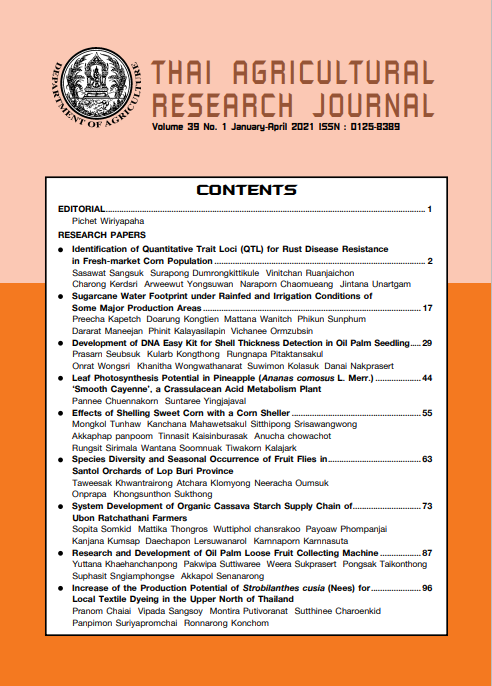System development of organic cassava starch supply chain of Ubon Ratchathani farmers
DOI:
https://doi.org/10.14456/thaidoa-agres.2021.7Keywords:
logistic, supply chain, cassava, tapioca starch, organicAbstract
The development of organic tapioca starch throughout the supply chain in Ubon Ratchathani province was carried out in 2016 with the following objectives: 1) to assess the cost of organic tapioca starch production system throughout the supply chain, 2) to compare methods and cost structure of activities in the supply chain as well as the logistics system of organic cassava starch and 3) to develop farmers’ group so that they were able to adopt the organic cassava standards of USDA, NOP or EU Organic system. It was found
that the farmer’s cost in organic cassava production was 11,935 baht/rai, while in nonorganic cassava the cost was 8,410 baht/rai. Although the production cost of organic cassava was higher than that of non-organic cassava, due to the higher purchase price of organic cassava, the sale of organic cassava roots were satisfactory to the organic farmers. It was found that the production cost per kilogramme of organic cassava starch that enters to the factory was 8.60 baht higher than that of non-organic cassava starch. The production cost and selling price of non-organic cassava were 13.76 baht /kg. and 14.91 baht/kg with the the profit of 1.15 baht/kg while the production cost and selling price of organic tapioca starch were 22.36 baht/kg. and 22.31 baht/kg., which resulted in a loss of 0.05 baht/kg. This was due to the additional cost of 3.20 baht/kg for standard certification fee in the production system according to the USDA NOP or EU Organic standards. Farmers who were certified under USDA NOP or EU Organic system and produced by using the technology of the Department of Agriculture and the Organic Crop Production Manual were able to produce organic cassava to achieve the target yield of 4.5 tons/rai, which was higher than the national average.
References
กรมการข้าว. 2560 มาตรฐานสินค้าเกษตรอินทรีย์ของสหภาพยุโรป EU. แหล่งข้อมูล: https://www.thairicedb.com/standard-detail.php?id=5. สืบค้น: 10 ธันวาคม 2562.
กรมเจรจาการค้าระหว่างประเทศ. 2558. มันสำปะหลัง : พืชเศรษฐกิจที่น่าจับตา ปี 2558. แหล่งข้อมูล: https://www.ryt9.com/s/beco/2263888. สืบค้น: 10 ธันวาคม 2562.
กรมพัฒนาที่ดิน. 2550. การใช้ปุ๋ยพืชสดเพื่อปรับปรุงบำรุงดิน. แหล่งข้อมูล: https://www.ldd.go.th/menu_Dataonline/G1/G1_02.pdf. สืบค้น: 10 ธันวาคม 2562.
ภัสชญภณ หมื่นแจ้ง สาลี่ ชื่นสถิต และพัชรีวรรณ จงจิตเมตต์. 2558. รายงานชุดโครงการวิจัยการวิจัยและพัฒนาเกษตรอินทรีย์. กรมวิชาการเกษตร. 101 หน้า.
ภัสชญภณ หมื่นแจ้ง. 2557. ผลการใช้ปุ๋ยชีวภาพพีจีพีอาร์เพื่อเพิ่มคุณภาพและผลผลิตมันสำปะหลัง. หน้า 349-363. ใน: รายงานผลงานวิจัยโครงการวิจัยและพัฒนาวิธีการเขตกรรมมันสำปะหลัง ประจำปี 2554. สถาบันวิจัยพืชไร่และพืชทดแทนพลังงาน, กรมวิชาการเกษตร.
ศรีสุดา ทิพยรักษ์. 2552. การย่อยสลายและปลดปล่อยไนโตรเจนจากซากถั่วลิสงและถั่วเขตร้อนอื่นๆ เพื่อเป็น ปุ๋ยพืชสดให้แก่อ้อยที่ปลูกปลายฤดูฝน. วิทยานิพนธ์ปริญญาปรัชญาดุษฎีบัณฑิต สาขาวิชาพืชไร่ บัณฑิตวิทยาลัย, มหาวิทยาลัยขอนแก่น.
สมปอง หมื่นแจ้ง ประไพ ทองระอา กลัยกร โปร่งจันทึก ประสาท เปลี่ยนสิน ไพทูรย์ พลูสวัสดิ์ สุทัด ปินเสน กุลธิดา ดอนอยู่ไพร อุชฎา สุขจันทร์ สุกิจ รัตนศรีวงษ์ นวลจันทร์ ศรีสมบัติ ศิริจันทร์ อินทร์น้อย เพทาย กาญจนเกสร สมพงษ์ กาทอง กมลภัทร์ ศิริพงษ์ พงษ์มานิตย์ ไทยแท้ บรรเทา จันทร์พุ่ม อัมรา หาญจวณิช อัจฉรา นันทกิจ ประภาศรี จงประดิษฐ์นันท์ และณัณจณา ลือตระกูล. การพัฒนาระบบการผลิตปุ๋ยหมักแบบเติมอากาศในฟาร์มผลิตพืชอินทรีย์. 2558. แหล่งข้อมูล: http://www.doa.go.th/research/showthread.php?tid=140. สืบค้น: 10 ธันวาคม 2562.
สำนักงานเกษตรและสหกรณ์จังหวัดอุบลราชธานี 2562. เอกสารการประชุมแนวทางการขับเคลื่อนการพัฒนาและแก้ไขปัญหาภาคการเกษตรด้านอุตสาหกรรม จังหวัดอุบลราชธานี. 44 หน้า.
สำนักงานเศรษฐกิจการเกษตร. 2560. ระบบฐานข้อมูลและการให้บริการข้อมูลการค้าเกษตรต่างประเทศของประเทศไทย. แหล่งข้อมูล: http://impexp.oae.go.th/service/export.php.สืบค้น: 10 ธันวาคม 2562.
สำนักงานเศรษฐกิจการเกษตร. 2561. มันสําปะหลังโรงงาน : เนื้อที่เพาะปลูก เนื้อที่เก็บเกี่ยว ผลผลิต และผลผลิตต่อไร่ ปี 2561 (รายอําเภอ). แหล่งข้อมูล: http://www.oae.go.th/ assets/portals/1/fileups/prcaidata/files/cassava_dit61.pdf. สืบค้น: 10 ธันวาคม 2562.
สำนักงานเศรษฐกิจการเกษตร. 2562. มันสำปะหลัง : ราคามันสำปะหลังรายเดือนที่เกษตรกรขายได้ที่ไร่นาทั้งประเทศ ปี 2540 -2562. แหล่งข้อมูล: http://www.oae.go.th/assets/portals/1/files/price/monthly_price/casava.pdf.สืบค้น: 9 สิงหาคม 2563.
สุวลักษณ์ อะมะวัลย์. 2555. ผลของปุ๋ยชีวภาพพีจีพีอาร์ต่อการเพิ่มประสิทธิภาพการผลิตของมันสำปะหลัง. วิชาการค้นคว้าอิสระนี้เป็นส่วนหนึ่งของการศึกษาตามหลักสูตร วิทยาศาสตร์มหาบัณฑิต (การจัดการสิ่งแวดล้อม) คณะพัฒนาสังคมและสิ่งแวดล้อม สถาบันบัณฑิตพัฒนบริหารศาสตร์. 125 หน้า.
โสภิตา สมคิด พเยาว์ พรหมพันธุ์ใจ มัตติกา ทองรส กาญจนา คุ้มทรัพย์ เดชพนต์ เลิศสุวรรณโรจน์ และกัณฑ์พร กรรณสูต. 2561. การพัฒนาระบบการผลิตแป้งมันสำปะหลังอินทรีย์ตลอดห่วงโซ่การผลิตของเกษตรกรในจังหวัดอุบลราชธานีเพื่อเพิ่มศักยภาพการเป็นศูนย์กลางเกษตรอินทรีย์ในภูมิภาคอาเซียน. 125 หน้า.
โสฬส แซ่ลิ้ม.2559. เอกสารวิชาการเรื่องปุ๋ยอินทรีย์และการใช้ประโยชน์ในประเทศไทย กรมพัฒนาที่ดิน. แหล่งข้อมูล: http://www1.ldd.go.th/WEB_PSD/ Employee%20 Assessment/ wean/pch/pch38/3.pdf. สืบค้น: 10 ธันวาคม 2562.
Nagurney, A.. 2006. Supply Chain Network Economics: Dynamics of Prices, Flows, and Profits, Edward Elgar Publishing. ISBN 1-84542-916-8. 413 p.
Ponti, de T., B. Rijk and M.K. van Ittersum. 2011. The crop yield gap between organic and conventional agriculture. Available at :. https://www.sciencedirect.com/science/article/pii/S0308521X1100182X. Accessed : 2 March 2020.
Downloads
Published
How to Cite
Issue
Section
License
Copyright (c) 2021 Thai Agricultural Research Journal

This work is licensed under a Creative Commons Attribution-NonCommercial-NoDerivatives 4.0 International License.
Thai Agricultural Research Journal



